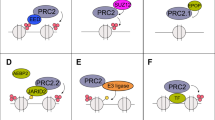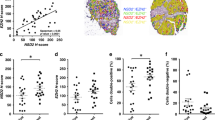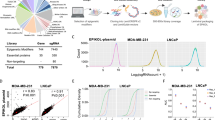Abstract
Our understanding of key epigenetic regulators involved in specific biological processes and cancers is still incomplete, despite great progress in genome-wide studies of the epigenome. Here, we carried out a systematic, genome-wide analysis of the functional significance of 615 epigenetic proteins in prostate cancer (PrCa) cells. We used the high-content cell-spot microarray technology and siRNA silencing of PrCa cell lines for functional screening of cell proliferation, survival, androgen receptor (AR) expression, histone methylation and acetylation. Our study highlights subsets of epigenetic enzymes influencing different cancer cell phenotypes. Plant homeo domain (PHD) finger proteins have a key role in cell survival and histone methylation, whereas histone deacetylases were primarily involved in regulating AR expression. In contrast, JumonjiC-domain (JmjC) containing histone lysine demethylases (KDMs) mainly had an impact on cell proliferation. Our results show that the KDMs JARID1B, PHF8, KDM3A, KDM3B and KDM4A were highly expressed in clinical PrCa samples. The PHD-finger protein 8 (PHF8), a transcriptional coactivator with both PHD- and JmjC-domains, was moderately to strongly expressed in 80% of clinical PrCa samples, whereas 76% of normal and benign samples were negative or only showed weak PHF8 expression. Strong PHF8 expression correlated significantly with high Gleason grade and was borderline significant for poor prognosis. The results of functional PHF8 knockdown implicate a role in cell migration and invasion, as shown by cell motility and 3-D invasion assays. Our study suggests that various cellular phenotypes are regulated by distinct subsets of epigenetic enzymes. Proteins interpreting and modifying histone methylation, such as JmjC-domain and particularly PHD-finger proteins like PHF8, are activated in subsets of PrCa's and promote cancer relevant phenotypes.
This is a preview of subscription content, access via your institution
Access options
Subscribe to this journal
Receive 50 print issues and online access
$259.00 per year
only $5.18 per issue
Buy this article
- Purchase on Springer Link
- Instant access to full article PDF
Prices may be subject to local taxes which are calculated during checkout






Similar content being viewed by others
References
Abbott A . (2010). Project set to map marks on genome. Nature 463: 596–597.
Abidi FE, Miano MG, Murray JC, Schwartz CE . (2007). A novel mutation in the PHF8 gene is associated with X-linked mental retardation with cleft lip/cleft palate. Clin Genet 72: 19–22.
Baker LA, Allis CD, Wang GG . (2008). PHD fingers in human diseases: disorders arising from misinterpreting epigenetic marks. Mutat Res 647: 3–12.
Bianco-Miotto T, Chiam K, Buchanan G, Jindal S, Day TK, Thomas M et al. (2010). Global levels of specific histone modifications and an epigenetic gene signature predict prostate cancer progression and development. Cancer Epidemiol Biomarkers Prev 19: 2611–2622.
Birmingham A, Selfors LM, Forster T, Wrobel D, Kennedy CJ, Shanks E et al. (2009). Statistical methods for analysis of high-throughput RNA interference screens. Nat Methods 6: 569–575.
Bjorkman M, Iljin K, Halonen P, Sara H, Kaivanto E, Nees M et al. (2008). Defining the molecular action of HDAC inhibitors and synergism with androgen deprivation in ERG-positive prostate cancer. Int J Cancer 123: 2774–2781.
Chandran UR, Ma C, Dhir R, Bisceglia M, Lyons-Weiler M, Liang W et al. (2007). Gene expression profiles of prostate cancer reveal involvement of multiple molecular pathways in the metastatic process. BMC Cancer 12: 64.
Cloos PA, Christensen J, Agger K, Maiolica A, Rappsilber J, Antal T et al. (2006). The putative oncogene GASC1 demethylates tri- and dimethylated lysine 9 on histone H3. Nature 442: 307–311.
Cooper CS, Foster CS . (2009). Concepts of epigenetics in prostate cancer development. Br J Cancer 100: 240–245.
Dunning MJ, Smith ML, Ritchie ME, Tavare S . (2007). Beadarray: R classes and methods for illumina bead-based data. Bioinformatics 23: 2183–2184.
Egger G, Liang G, Aparicio A, Jones PA . (2004). Epigenetics in human disease and prospects for epigenetic therapy. Nature 429: 457–463.
Ellinger J, Kahl P, von der Gathen J, Rogenhofer S, Heukamp LC, Gutgemann I et al. (2010). Global levels of histone modifications predict prostate cancer recurrence. Prostate 70: 61–69.
Ellis L, Atadja PW, Johnstone RW . (2009). Epigenetics in cancer: targeting chromatin modifications. Mol Cancer Ther 8: 1409–1420.
Ernst J, Kellis M . (2010). Discovery and characterization of chromatin states for systematic annotation of the human genome. Nat Biotechnol 28: 817–825.
Feng W, Yonezawa M, Ye J, Jenuwein T, Grummt I . (2010). PHF8 activates transcription of rRNA genes through H3K4me3 binding and H3K9me1/2 demethylation. Nat Struct Mol Biol 17: 445–450.
Flamand V, Zhao H, Peehl DM . (2010). Targeting monoamine oxidase A in advanced prostate cancer. J Cancer Res Clin Oncol 11: 1761–1771.
Fortschegger K, de Graaf P, Outchkourov NS, van Schaik FM, Timmers HT, Shiekhattar R . (2010). PHF8 targets histone methylation and RNA polymerase II to activate transcription. Mol Cell Biol 30: 3286–3298.
Fraga MF, Ballestar E, Villar-Garea A, Boix-Chornet M, Espada J, Schotta G et al. (2005). Loss of acetylation at Lys16 and trimethylation at Lys20 of histone H4 is a common hallmark of human cancer. Nat Genet 37: 391–400.
Guo W, Giancotti FG . (2004). Integrin signalling during tumour progression. Nat Rev Mol Cell Biol 5: 816–826.
Halkidou K, Gaughan L, Cook S, Leung HY, Neal DE, Robson CN . (2004). Upregulation and nuclear recruitment of HDAC1 in hormone refractory prostate cancer. Prostate 59: 177–189.
Harma V, Virtanen J, Makela R, Happonen A, Mpindi JP, Knuuttila M et al. (2010). A comprehensive panel of three-dimensional models for studies of prostate cancer growth, invasion and drug responses. PLoS One 5: e10431.
Holst CR, Nuovo GJ, Esteller M, Chew K, Baylin SB, Herman JG et al. (2003). Methylation of p16(INK4a) promoters occurs in vivo in histologically normal human mammary epithelia. Cancer Res 63: 1596–1601.
Horton JR, Upadhyay AK, Qi HH, Zhang X, Shi Y, Cheng X . (2010). Enzymatic and structural insights for substrate specificity of a family of jumonji histone lysine demethylases. Nat Struct Mol Biol 17: 38–43.
Hosack DA, Dennis G, Sherman BT, Lane HC, Lempicki RA . (2003). Identifying biological themes within lists of genes with EASE. Genome Biol 4: R70.
Kahl P, Gullotti L, Heukamp LC, Wolf S, Friedrichs N, Vorreuther R et al. (2006). Androgen receptor coactivators lysine-specific histone demethylase 1 and four and a half LIM domain protein 2 predict risk of prostate cancer recurrence. Cancer Res 66: 11341–11347.
Kilpinen S, Autio R, Ojala K, Iljin K, Bucher E, Sara H et al. (2008). Systematic bioinformatic analysis of expression levels of 17,330 human genes across 9,783 samples from 175 types of healthy and pathological tissues. Genome Biol 9: R139.
Kleine-Kohlbrecher D, Christensen J, Vandamme J, Abarrategui I, Bak M, Tommerup N et al. (2010). A functional link between the histone demethylase PHF8 and the transcription factor ZNF711 in X-linked mental retardation. Mol Cell 10: 1016.
Koivisto AM, Ala-Mello S, Lemmela S, Komu HA, Rautio J, Jarvela I . (2007). Screening of mutations in the PHF8 gene and identification of a novel mutation in a finnish family with XLMR and cleft lip/cleft palate. Clin Genet 72: 145–149.
Lange SS, Mitchell DL, Vasquez KM . (2008). High mobility group protein B1 enhances DNA repair and chromatin modification after DNA damage. Proc Natl Acad Sci USA 105: 10320–10325.
Laumonnier F, Holbert S, Ronce N, Faravelli F, Lenzner S, Schwartz CE et al. (2005). Mutations in PHF8 are associated with X linked mental retardation and cleft lip/cleft palate. J Med Genet 42: 780–786.
Lee MG, Wynder C, Schmidt DM, McCafferty DG, Shiekhattar R . (2006). Histone H3 lysine 4 demethylation is a target of nonselective antidepressive medications. Chem Biol 13: 563–567.
Liu W, Tanasa B, Tyurina OV, Zhou TY, Gassmann R, Liu WT et al. (2010). PHF8 mediates histone H4 lysine 20 demethylation events involved in cell cycle progression. Nature 466: 508–512.
Loenarz C, Ge W, Coleman ML, Rose NR, Cooper CD, Klose RJ et al. (2010). PHF8, a gene associated with cleft lip/palate and mental retardation, encodes for an nepsilon-dimethyl lysine demethylase. Hum Mol Genet 19: 217–222.
Mellor J . (2006). It takes a PHD to read the histone code. Cell 126: 22–24.
Metzger E, Wissmann M, Yin N, Muller JM, Schneider R, Peters AH et al. (2005). LSD1 demethylates repressive histone marks to promote androgen-receptor-dependent transcription. Nature 437: 436–439.
Minucci S, Pelicci PG . (2006). Histone deacetylase inhibitors and the promise of epigenetic (and more) treatments for cancer. Nat Rev Cancer 6: 38–51.
Qi HH, Sarkissian M, Hu GQ, Wang Z, Bhattacharjee A, Gordon DB et al. (2010). Histone H4K20/H3K9 demethylase PHF8 regulates zebrafish brain and craniofacial development. Nature 466: 503–507.
Qiao Y, Liu X, Harvard C, Hildebrand MJ, Rajcan-Separovic E, Holden JJ et al. (2008). Autism-associated familial microdeletion of Xp11.22. Clin Genet 74: 134–144.
Rantala JK, Edgren H, Lehtinen L, Wolf M, Kleivi K, Aaltola AR et al. (2010). Integrative functional genomics analysis of sustained polyploidy phenotypes in breast cancer cells identifies an oncogenic profile forGINS2. Neoplasia 12: 877–888.
Rantala JK, Makela R, Aaltola AR, Laasola P, Mpindi JP, Nees M et al. (2011). A cell spot microarray method for production of high density siRNA transfections microarrays. BMC Genomics 12: 162–176.
Rose NR, Ng SS, Mecinovic J, Lienard BM, Bello SH, Sun Z et al. (2008). Inhibitor scaffolds for 2-oxoglutarate-dependent histone lysine demethylases. J Med Chem 51: 7053–7056.
Ruthenburg AJ, Allis CD, Wysocka J . (2007). Methylation of lysine 4 on histone H3: Intricacy of writing and reading a single epigenetic mark. Mol Cell 25: 15–30.
Seligson DB, Horvath S, McBrian MA, Mah V, Yu H, Tze S et al. (2009). Global levels of histone modifications predict prognosis in different cancers. Am J Pathol 174: 1619–1628.
Seligson DB, Horvath S, Shi T, Yu H, Tze S, Grunstein M et al. (2005). Global histone modification patterns predict risk of prostate cancer recurrence. Nature 435: 1262–1266.
Sharma S, Kelly TK, Jones PA . (2010). Epigenetics in cancer. Carcinogenesis 31: 27–36.
Shi X, Kachirskaia I, Walter KL, Kuo JH, Lake A, Davrazou F et al. (2007). Proteome-wide analysis in saccharomyces cerevisiae identifies several PHD fingers as novel direct and selective binding modules of histone H3 methylated at either lysine 4 or lysine 36. J Biol Chem 282: 2450–2455.
Shin S, Janknecht R . (2007). Activation of androgen receptor by histone demethylases JMJD2A and JMJD2D. Biochem Biophys Res Commun 359: 742–746.
Smith EH, Janknecht R, Maher III LJ . (2007). Succinate inhibition of alpha-ketoglutarate-dependent enzymes in a yeast model of paraganglioma. Hum Mol Genet 16: 3136–3148.
Tang D, Kang R, Zeh III HJ, Lotze MT . (2010). High-mobility group box 1 and cancer. Biochim Biophys Acta 1799: 131–140.
Taylor BS, Schultz N, Hieronymus H, Gopalan A, Xiao Y, Carver BS et al. (2010). Integrative genomic profiling of human prostate cancer. Cancer Cell 18: 11–22.
Tuomi S, Mai A, Nevo J, Laine JO, Vilkki V, Ohman TJ et al. (2009). PKCepsilon regulation of an alpha5 integrin-ZO-1 complex controls lamellae formation in migrating cancer cells. Sci Signal 2: ra32.
Weichert W, Roske A, Gekeler V, Beckers T, Stephan C, Jung K et al. (2008). Histone deacetylases 1, 2 and 3 are highly expressed in prostate cancer and HDAC2 expression is associated with shorter PSA relapse time after radical prostatectomy. Br J Cancer 98: 604–610.
Welsbie DS, Xu J, Chen Y, Borsu L, Scher HI, Rosen N et al. (2009). Histone deacetylases are required for androgen receptor function in hormone-sensitive and castrate-resistant prostate cancer. Cancer Res 69: 958–966.
Wissmann M, Yin N, Muller JM, Greschik H, Fodor BD, Jenuwein T et al. (2007). Cooperative demethylation by JMJD2C and LSD1 promotes androgen receptor-dependent gene expression. Nat Cell Biol 9: 347–353.
Wolf SS, Patchev VK, Obendorf M . (2007). A novel variant of the putative demethylase gene, s-JMJD1C, is a coactivator of the AR. Arch Biochem Biophys 460: 56–66.
Xiang Y, Zhu Z, Han G, Ye X, Xu B, Peng Z et al. (2007). JARID1B is a histone H3 lysine 4 demethylase up-regulated in prostate cancer. Proc Natl Acad Sci USA 104: 19226–19231.
Yamane K, Toumazou C, Tsukada Y, Erdjument-Bromage H, Tempst P, Wong J et al. (2006). JHDM2A, a JmjC-containing H3K9 demethylase, facilitates transcription activation by androgen receptor. Cell 125: 483–495.
Zhu Z, Wang Y, Li X, Wang Y, Xu L, Wang X et al. (2010). PHF8 is a histone H3K9me2 demethylase regulating rRNA synthesis. Cell Res 20: 794–801.
Acknowledgements
We thank Professor Tony Kouzarides from The Gurdon Institute, University of Cambridge for valuable suggestions and insights in constructing the epigenetic siRNA library. We thank Daniela Kleine-Kohlbrecher and Professor Kristian Helin from Biotech Research and Innovation Centre (BRIC), University of Copenhagen, Denmark, for insightful discussions, sharing unpublished results and PHF8 over expression construct. We thank Arho Virkki and Elmar Bucher for assistance with gene expression data normalization. This study was supported by grants from Academy of Finland (grant Nr. 111456 to MN, VH), EU-EPITRON (contract # LSHC-CT-2005-518417 to MB, OK), Marie Curie Canceromics (MEXT-CT-2003-2728 to OK), Cancer Organizations Finland and Sigrid Juselius Foundation (JPM, JR).
Author information
Authors and Affiliations
Corresponding author
Ethics declarations
Competing interests
The authors declare no conflict of interest.
Additional information
Supplementary Information accompanies the paper on the Oncogene website
Supplementary information
Rights and permissions
About this article
Cite this article
Björkman, M., Östling, P., Härmä, V. et al. Systematic knockdown of epigenetic enzymes identifies a novel histone demethylase PHF8 overexpressed in prostate cancer with an impact on cell proliferation, migration and invasion. Oncogene 31, 3444–3456 (2012). https://doi.org/10.1038/onc.2011.512
Received:
Revised:
Accepted:
Published:
Issue Date:
DOI: https://doi.org/10.1038/onc.2011.512
Keywords
This article is cited by
-
The emerging roles of histone demethylases in cancers
Cancer and Metastasis Reviews (2024)
-
Loss of PHF8 induces a viral mimicry response by activating endogenous retrotransposons
Nature Communications (2023)
-
Targeting the methyltransferase SETD8 impairs tumor cell survival and overcomes drug resistance independently of p53 status in multiple myeloma
Clinical Epigenetics (2021)
-
P53 vs NF-κB: the role of nuclear factor-kappa B in the regulation of p53 activity and vice versa
Cellular and Molecular Life Sciences (2020)
-
Targeting epigenetic regulators for cancer therapy: mechanisms and advances in clinical trials
Signal Transduction and Targeted Therapy (2019)



